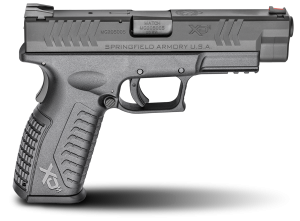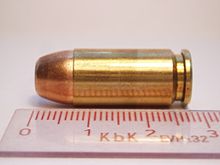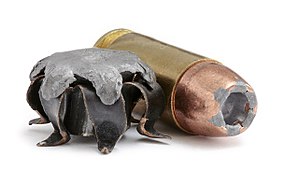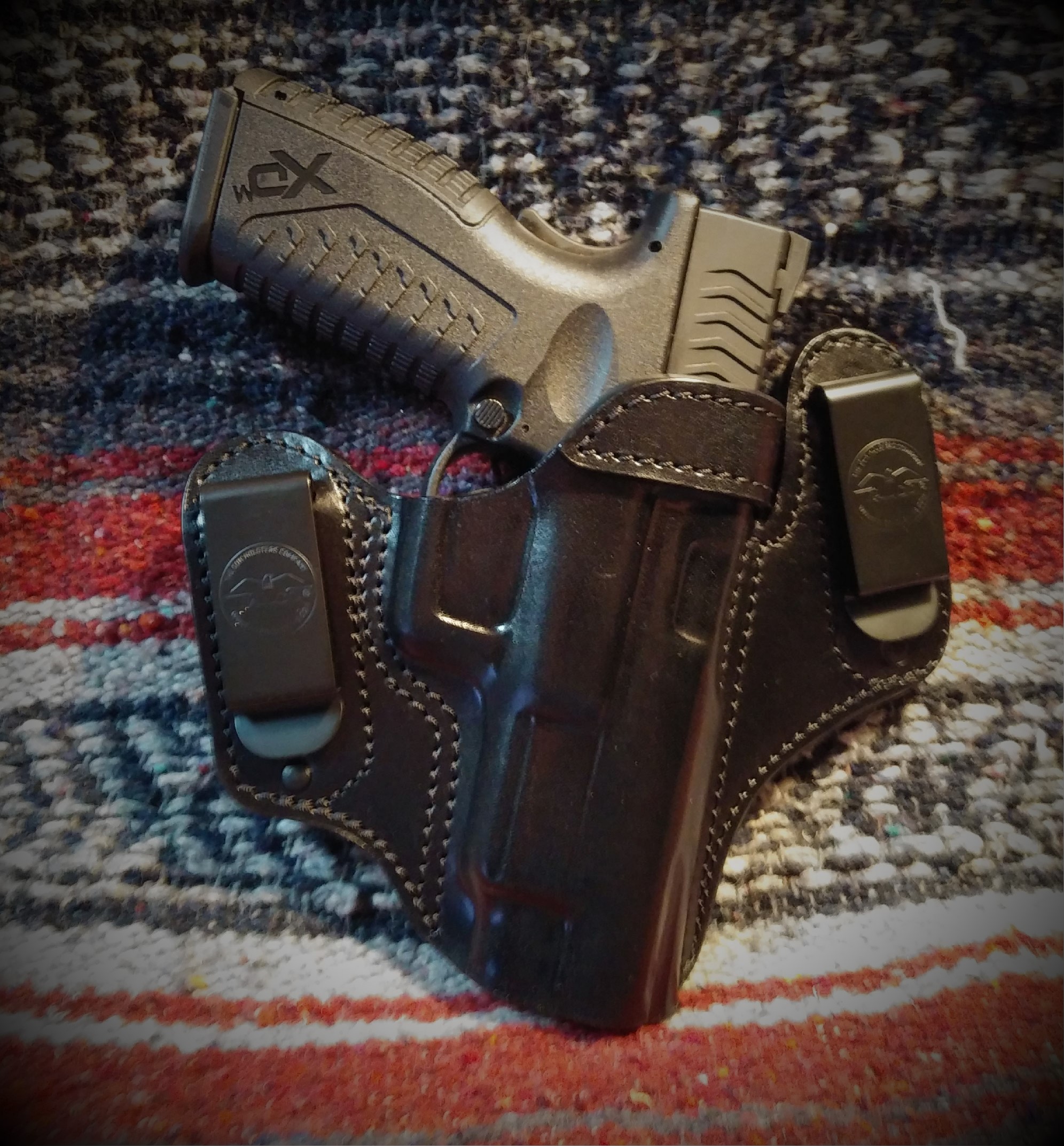 “The energy of the .40 S&W exceeds standard-pressure .45 ACP loadings, generating between 350 foot-pounds (470 J) and 500 foot-pounds (680 J) of energy, depending on bullet weight. Both the .40 S&W and the 9mm Parabellum operate at a 35,000 pounds per square inch (240 MPa) SAAMI maximum, compared to a 21,000 pounds per square inch (140 MPa) maximum for .45 ACP.” – Source: https://en.wikipedia.org/wiki/.40_S%26W.
“The energy of the .40 S&W exceeds standard-pressure .45 ACP loadings, generating between 350 foot-pounds (470 J) and 500 foot-pounds (680 J) of energy, depending on bullet weight. Both the .40 S&W and the 9mm Parabellum operate at a 35,000 pounds per square inch (240 MPa) SAAMI maximum, compared to a 21,000 pounds per square inch (140 MPa) maximum for .45 ACP.” – Source: https://en.wikipedia.org/wiki/.40_S%26W.
I have to admit that I am a proponent of the .45ACP cartridge, having fired quite a few of them through quite a few 1911-based pistols. I also have to admit that I am usually late in discovering different cartridges due to either investment in certain defensive cartridges (such as; .38 Special, .357 magnum, and 9mm) or new cartridges that seemed out of line with (my) mainstream thinking. While following my typical (and sometimes misguided and biased) logic, I have to force myself to really look at calibers other than what I rely on for self-defense or just plain target shooting for fun.
When the .40 Smith and Wesson cartridge was developed, I was not one of those who excitedly jumped on the bandwagon. Rather, I wanted to lay back and let the dust settle. Some considered the .40 Smith and Wesson a ‘filler’ cartridge between the 9mm and the .45 ACP cartridge. That; however, is simply not the truth. The .40 Smith and Wesson, as with the 10mm cartridge, is a class unto itself. The one thing that I will not say is that the “S&W” does not stand for short and wimpy. This cartridge has some clout.

The Test Platform – the Springfield XDm 40 4.5
For my evaluation of the .40 S&W, I needed a platform from which to shoot it, of which I had none. I had shot the .40 Smith & Wesson in various range guns to include the Ruger SR40, a Glock G27, and a Springfield XD 4.5. All shot fine and I was fairly accurate with them all. I was; however, more comfortable with the Springfield XD 4.5 since I have the XDm 9 and the XDm 45 in 4.5-inch barrel lengths. I also wanted to give the .40 S&W a chance in the same XDm model to keep the evaluation equal by using the same type product from the same manufacturer. A Springfield XDM9202HCE (aka, the XDm40 4.5) was ordered through my favorite LGS. I also had to order 40 S&W ammunition since I had none. An order was placed for some ‘practice’ and ‘defensive’ ammunition. The wait began for both and was chomping on the bit in anticipation of their arrival. If I decided, at some later time, to carry the .40 S&W for defensive purposes, I would probably be looking at a 1911-based platform for EDC, as it is the most familiar to me and I feel very comfortable with one on the hip. However, that could change depending on if I found the right pistol for the cartridge.
Author’s Note: Since I have already reviewed the Springfield XDm 9 4.5 (https://guntoters.com/blog/2018/01/28/springfield-armory-xdm-9mm-4-5/) and the Springfield XDm 45 4.5 (https://guntoters.com/blog/2016/10/12/springfield-armory-xdm-4-5-45acp-pistol-review/), I felt no need to review the XDm 40 4.5, but I kinda, sort of did anyway: https://guntoters.com/blog/2018/05/13/springfield-xdm-40-4-5-vs-glock-g22/ .
I wanted the ammunition to be similar to what I would carry for self-defense (if I ever decided to carry a pistol chambered for it). It seemed that 168-grain and 180-grain were the two most popular choices. Being that I like heavy bullets, the 180-grain seemed to be a good choice. For practice, I chose the Sellier and Bellot SB40B, 180-grain FMJ (968fps) and Federal 40HS1 180-grain Hydra-Shok (1000fps) for defense load evaluation. How well these cartridges would perform in the Springfield XDm 40 4.5 was simply speculation at this point. For 9mm carry, I am starting to like the Hornady 147-grain XTP and for 1911 carry, the 230-grain Sig Sauer V-Crown JHP is the most accurate (so far) out of my usual EDC (Rock Island 1911 Tactical FS), and is just as accurate through the Ruger SR1911CMD-A. If my local range has the SIG Sauer .40 S&W Ammunition V-Crown JHP, 165-grain ammunition on hand, I may just try a few of those for comparison sake.
While the wait for firearm and ammunition ensued, I decided to engage my fellow shooting companions in a debate about the .40 Smith & Wesson cartridge, and which neither of my shooting companions own nor have pistols which with to shoot it. One is a die-hard Glock 9mm fan and the other a die-hard 1911 guy.
The first engagement was in the fact that with modern ammunition the 9mm cartridge is nearly identical in performance with the .40 Smith & Wesson and that I should have, instead, simply upped the anti and went with the 10mm cartridge. A second engagement concerned the performance of the .40 Smith and Wesson cartridge to my beloved 230-grain .45ACP cartridge. Again, the propensity of both of my companions was to place the .40 Smith & Wesson someplace in the middle of the 9x19mm (the 9mm Parabellum or Luger) and the 11.43x23mm cartridge (the .45ACP), which if you consider size as a factor, 10mm does indeed fall between the two sizes (Doh!).

.40 Smith & Wesson
The .40 Smith & Wesson shares the same maximum case pressure as the 9mm cartridge, which is about 35,000 psi. Both the 9mm and .40 Smith & Wesson maximum case pressure is greater than the .45ACP, which is about 21,000 psi. Because of bullet weights, I suppose that the .40 Smith & Wesson could be considered as a ‘continuation’ of the 9mm cartridge, but that would not be necessarily true. The .45 caliber Federal 165-grain Hydra-shok’s velocity is around 1,060 fps with 412 foot-pounds of energy while a .40 caliber Federal 165-grain Federal FMJ travels around 1,130 fps with 468 foot-pounds of energy. While these figures are so close, some would respond with. “But, the .45Acp is a much bigger bullet!” Again, well doh! We could go on and on with these comparisons until pigs fly, all the while knowing that all figures are speculative in nature. But, it sure is fun to engage in debate about them, and I find that, on one occasion, the .45ACP cartridge is quite interesting when compared to the same bullet weight in a .40 S&W pistol – the Speer Lawman 200-grain bullet.
According to the 5th Edition of Ammo & Ballistics, the Speer 200-grain TMJ FN Lawman bullet, .40 S&W, has a muzzle velocity of 915fps out of a 4” barrel with 372 foot-pounds of energy. By comparison, the Speer 200-grain TMJ FN lawman, in .45ACP, has a muzzle velocity out of a 5” barrel of 975fps with 422 foot pounds of energy. In short, the 200-grain bullet, in this case, is the more powerful cartridge; albeit a one-inch barrel length advantage.
 What matters to me is how a firearm (of my choosing) sends a projectile (of my choosing) downrange at a time (of my choosing, or not) to the target. After that, everything is on its own regardless of my desired results. In target shooting, I simply want the resulting hole to appear in the target where I expect it to appear in the target. In a defensive situation, I want the same; however, I also want the person who is intent on doing me harm to stop what they are doing. A paper target will not harm me unless I get a paper cut while hanging the target and begin bleeding. Then, the paper target better beware!
What matters to me is how a firearm (of my choosing) sends a projectile (of my choosing) downrange at a time (of my choosing, or not) to the target. After that, everything is on its own regardless of my desired results. In target shooting, I simply want the resulting hole to appear in the target where I expect it to appear in the target. In a defensive situation, I want the same; however, I also want the person who is intent on doing me harm to stop what they are doing. A paper target will not harm me unless I get a paper cut while hanging the target and begin bleeding. Then, the paper target better beware!
Now, the question is that if the .40 Smith & Wesson is such an effective cartridge, why are some law-enforcement agencies looking back to the 9mm cartridge? I agree that modern 9mm ammunition has, indeed improved. I also agree that the 9mm cartridge is pleasant to shoot (depending on the firearm) and from a “service” pistol fast follow-up shots are possible. I also know the propensity of people to push things to the limit and believe that going to a +p or +P+ will cure the ills of the “wimpy” 9mm cartridge. I have also seen the results of pistol abuse if the pistol is not properly set up to handle the +p or +P+ ammunition. In seeking a more powerful cartridge than the standard 9mm, the 10mm “Kurz” seemed to be an answer. A new pistol had to be developed for the 10mm “Kurz” and the S&W Model 4006 semi-automatic handgun was introduced by Smith & Wesson on January 17, 1990 along with the new .40 S&W cartridge.
Other firearm manufacturers jumped to the new cartridge and mostly modified existing 9mm firearms to handle the new cartridge, with Glock being the first to the mass market. Aside from the obvious barrel and feed mechanism changes, modifications were simple; increase the recoil spring rate and beef up the extractor. With increased power; however, comes increased recoil energy. Some had a problem with an increase in recoil with a much sharper pulse than with the 9mm cartridge. In this sense, the .40S&W cartridge fell in between the gentle recoil pulse of the 9mm and the somewhat hard push of the .45ACP cartridge. Again; however, folks were looking capacity and the .40 S&W provided enough ammunition; albeit, usually one less round than the 9mm pistol. But, that was acceptable given the power of the .40 S&W over the 9mm cartridge. Still, there was a propensity of most LEOs not to shoot the .40 S&W as well as the 9mm. But, was it because of the cartridge or the platform from which it was shot from? Unfortunately, most LEOs are issued pistols that may not be suitable for them and people (yes, LEOs are people) being different meant that not all would adapt to the “new” platform – even though the platform may have been the same as what they used with the 9mm. For example, the Glock G17 and the Glock G22 are nearly identical. It would seem that if you can shoot one that you can shoot the other. That did not seem to be the case; however, with a more powerful cartridge being fired. Now, it seems that more agencies are returning to the 9mm since improvements in ballistics and bullet design have been made. There are; however, those that favors the .40 S&W as a defensive cartridge and, in fact, would prefer the 10mm cartridge over it. In fact, I had been told by one shooting companion that I should forget about the .40 S&W and simply jump into a 10mm cartridge. My response to that was, “Why don’t I just change out the recoil spring in my 1911 and shoot a Cor-Bon 165-grain JHP +P cartridge (1250 fps w/573 foot-pounds of energy) .45ACP cartridge and accomplish the same thing?”
Those who say that the felt recoil of the .40 S&W is snappy may have never fired a compact revolver that is loaded with standard 158-grain .38 Special ammunition. That, my friends, is “snappy!”
Are we pointing fingers at the cartridge, the firearm, or the operator? Of the three factors given, the operator is the most flexible; when I pull a trigger, my trigger finger always points back at me. I have the responsibility to choose the firearms platform that works best for me and is always in my favor.
The Springfield XDM9202HCE and ammunition arrived within days of each other. The Springfield XDM9202HCE was thoroughly cleaned, properly lubed, and was now ready to be put to work.
 To start this range portion of the review, let me say that I actually like the sharp recoil impulse of the .40 S&W cartridge. I find my self getting very comfortable when firing a 9mm cartridge, given its low recoil characteristics. The sharp recoil impulse of the .40 S&W keeps my on my toes, as I work to keep the muzzle on target after each shot.
To start this range portion of the review, let me say that I actually like the sharp recoil impulse of the .40 S&W cartridge. I find my self getting very comfortable when firing a 9mm cartridge, given its low recoil characteristics. The sharp recoil impulse of the .40 S&W keeps my on my toes, as I work to keep the muzzle on target after each shot.
While I feel more comfortable firing a heavier pistol than the Springfield XDM9202HCE (30-ounces of dry weight), the pistol did an excellent job with the chosen .40 S&W ammunition. Recoil, while sharp, was straight back into the web of my shooting hand. As long as I did my part in maintaining a firm grip, muzzle jump was no more of an issue than with the .45 ACP cartridge through a 1911-based pistol. I was starting to like the .40 S&W cartridge.
By shooting session’s end, I was gaining a lot of confidence in the .40 S&W cartridge, more so than I have with the 9mm cartridge. Perhaps, it may be because of the heavier bullet weights than what is available for the 9mm, or that the .40 S&W is a more powerful cartridge than the 9mm, or maybe a combination of both. All things given, I would select the .40 S&W 180-grain or the 168-grain cartridge over the 9mm 124-grain as a defensive cartridge. Even with the reduced capacity of a 1911-based pistol (typically eight +1 rounds for a .40 S&W), I would not feel for want of enough defensive capability. However, 1911-based pistols for the .40S&W are limited to less than a handful (Springfield EMP (Author’s Note: Except for cost, I especially like the 1911 EMP® 4” Concealed Carry Contour .40SW [https://www.springfield-armory.com/products/1911-emp-4-concealed-carry-contour-40sw/]), Dan Wesson, Armscor, and STI as far as I know of).
Concealability
Even as a full-size service pistol, the XDM40 in 4.5 can be effectively concealed. One element of that concealment is the proper holster.
The Falco A112 Hawk holster, shown below, is one such holster.

The Falco A112 Hawk holster shown above is from Falco’s premium line dyed black for optimum concealment. Very little break-in was necessary.
Note that the holster works well with both the XDM40 4.5 and the XDM40 3.8. And, in fact, works well with the XDM45 and XDM9 in 4.5 and 3.8 lengths.
Summary
To some, high capacity simply means that you must be planning to miss a lot. With that said, the lowly .45Acp 230-grain JHP and the 125-grain .357 magnum pistol-caliber cartridges are still my personal chosen cartridges for defensive purposes; albeit a nod to the .38 Special +P in the right revolver. The .40 Smith & Wesson is garnering enough attention with me; however, and enough for me to invest in things ’40’ for a bit.
As far as the cartridge itself, I believe it to be a good defensive round that is simply a continuation of the 9mm; a heavier bullet weight(s) and a bit spunkier recoil. With the right pistol for the cartridge, I could be tempted to carry a .40 Smith & Wesson over the 9mm.
Although this assessment was about the .40 S&W cartridge, I can’t help but give a nod to the Springfield XDm 40 4.5 pistol. It is a full-size service pistol and concealing it IWB is a bit of a challenge with the long grip due to the 16-round capacity. However, its performance is worthy of the challenge, in my opinion. You can read my review of the Springfield XDm 40 4.5 @ https://guntoters.com/blog/2018/05/13/springfield-xdm-40-4-5-vs-glock-g22/.
The Bottom line is; however, how you, your chosen pistol, and your chosen caliber perform as a unit.
REFERENCES:
For more information regarding the .40 S&W: https://en.wikipedia.org/wiki/.40_S%26W
For more information regarding the Springfield XDm 40 4.5: https://www.springfield-armory.com/products/xdm-4-5-40-cal/
![]()


One Response to Springfield Armory XDm 40 4.5 (XDM9202HCE) My belated look at the 10mm “Kurz” (10x22 Smith and Wesson)